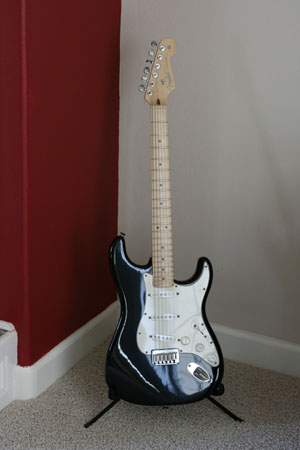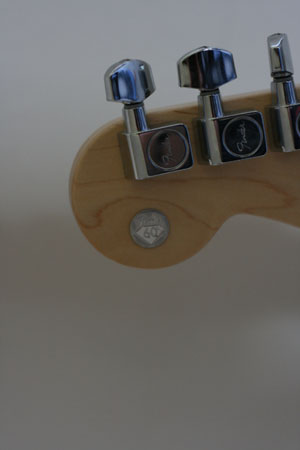 A couple of weekends ago I was out to lunch with my friend Erik and decided to visit the Cedar Rapids Music-Go-Round to see if they had anything interesting in stock. Over lunch we were discussing the amazing finds that he and our friend Andrew had in that store.
A couple of weekends ago I was out to lunch with my friend Erik and decided to visit the Cedar Rapids Music-Go-Round to see if they had anything interesting in stock. Over lunch we were discussing the amazing finds that he and our friend Andrew had in that store.
Admittedly Music-Go-Round can be pretty hit-and-miss when it comes to really great finds at a good price. Quite a bit of their stock caters to the beginner or low-budget musicians– the guy who really wants a Gibson Les Paul, but only has the funds for the LTD version of it (a good version for the price, BTW). When we got there they had quite a few Fenders hanging on the wall– a couple of Mexicans– but they had two American Stratocasters as well. One was a 2001 Hot Rod Red with tremolo and rosewood fretboard and the other was the 2005 black and white Hard Tail with maple neck that I ended up purchasing.
The salesman plugged me into a used Fender Blues Junior Combo Amp to try the guitars out. A good choice as the Blues Jr is partially tube and would be fairly well-matched to the classic Strat sound. After playing both guitars and conferring with Erik and calling Andrew on his cell I settled on the Hard Tail for a couple of reasons– one is that I really didn’t want a tremolo even though I could choose to block it (like Eric Clapton!) and the other is that I really like the feel of a maple neck.
The guitar was in immaculate shape and came with all of its swing tags and paperwork as well as the standard-issue plastic case for $549. This guitar lists for $1327.99, but you can get a new one for around $950 at online retailers. So, I feel like I got a pretty good deal.

Even though this guitar has a 2005 serial number (starting with “Z5”) it was sold as a 2006 model and has the Fender 60th Anniversary badge on the back of the headstock which is pretty cool. Another unique aspect of this guitar is that Fender discontinued the American Hard Tail in 2006. No new Hard Tails in ’07. I contacted Fender to confirm this as I see that most of the online retailers are still selling them even though the online catalog at fender.com doesn’t list it as current product. According to Fender the only way to get a Hard Tail guitar would be to order the Fender Robert Cray Standard Stratocaster Electric Guitar which is Mexican or to order the Eric Clapton Signature Strat, which has a blocked tremolo. Custom Shop Showmaster guitars come with Hard Tail as well.
This American Stratocaster is one of the post-2000 configurations. According to The Stratocaster Chronicles by Tom Wheeler, in the Summer of 2000 Fender discontinued the “American Standard” which had been in existence for 13 years and replaced it with the current “American Series.” The American Series was a new start to the Stratocaster line pulling together a set of features from the entire history of the Strat to that point making arguably the best Strat yet.
These features included the unanimously-agreed-superior pre-CBS 4-bolt neck, the Micro Tilt adjustment, the advanced shielding from the Standard, the 5-way pickup selector switch that dated back to 1977, “no-load” tone control which at “10” kills the tone pot on the middle pickup making for a vintage Strat tone, “Delta Tone” pickups where the middle pickup is wired in reverse of the other two providing a humbucking effect on certain switch settings, a single string tree on the head adding to tuning stability and improving tone, “rolled” neck edges which adds to the pleasant neck feel, non-veneered “original contour” body based on the 1950’s Strats, staggered pickup polepieces like the 1950’s Strats, and routing to provide the ability to add humbuckers in the neck and bridge positions. This final change eliminated the contraversial “swimming pool” routing where the area behind the pickguard was just a big hole to accomodate different pickup configurations.
Over the 53 years of the Stratocaster’s existence it has been subject to constant change– some of it good, some of it not good. In the American Series we see the benefits of a company looking back on the history of its products to pull a feature set together that I think ultimately makes an instrument that both honors its past, innovates and– most importantly– is great to play.
>pp 246-250, “Chapter 9: The New Millennium,”The Stratocaster Chronicles: Celebrating 50 Years of the Fender Strat, Tom Wheeler, 2004
Fender Musical Instruments Corporation
All Fender product names in this article are trademarks of Fender.
Check out the Fender Hard Tail Stratocasters at reverb.com!

